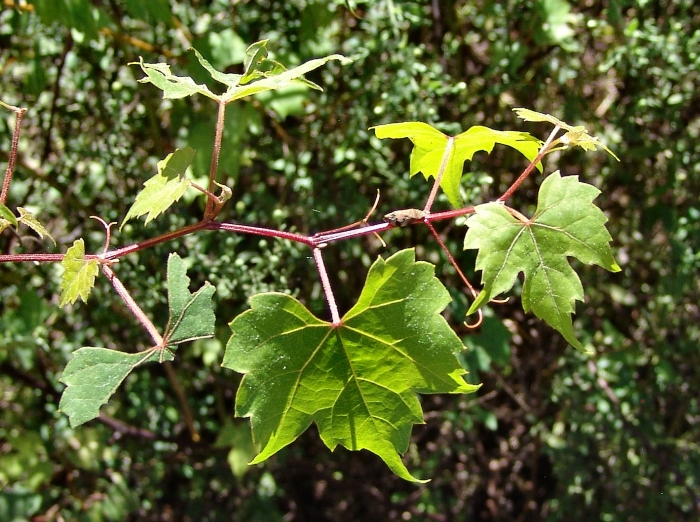Catbird Grape
(Vitis palmata)
Catbird Grape (Vitis palmata)
/
/

Gordon C. Snelling
CC BY 4.0
Image By:
Gordon C. Snelling
Recorded By:
Copyright:
CC BY 4.0
Copyright Notice:
Photo by: Gordon C. Snelling | License Type: CC BY 4.0 | License URL: http://creativecommons.org/licenses/by/4.0/ | Rights Holder: Gordon C. Snelling | Publisher: iNaturalist | Date Created: 2018-09-30T12:36:20-07:00 |





















Estimated Native Range
Summary
Vitis palmata, commonly known as Catbird Grape, is a deciduous climbing vine native to the moist lowland forests, riverbanks, and floodplains of the south-central and southeastern United States, extending from Texas to Florida and northward along the Mississippi Valley to Illinois. It can reach lengths of up to 50 feet (15 meters) when supported. The vine is characterized by its palmately lobed leaves, which are typically 5-7 lobed, and its ability to produce branched tendrils that facilitate climbing. During the flowering season in late spring to early summer, Vitis palmata produces small, greenish-white flowers that are not particularly showy. By late summer, these flowers give way to clusters of dark purple or blackish berries, which are a food source for birds and other wildlife.
Catbird Grape is valued for its ability to cover structures quickly and provide dense foliage, making it suitable for use as a natural screen or for erosion control on slopes. It is also appreciated for its wildlife value, as the berries are a favorite of catbirds and other bird species. In cultivation, it requires moist, well-drained soil and can tolerate a range of light conditions from full sun to partial shade. While it is not commonly used for grape production, the berries can be harvested to make wild grape jelly. Gardeners should be aware that this vine can become quite vigorous and may require pruning to keep it in check. Additionally, it can be susceptible to fungal diseases such as downy and powdery mildew, especially in humid climates.CC BY-SA 4.0
Catbird Grape is valued for its ability to cover structures quickly and provide dense foliage, making it suitable for use as a natural screen or for erosion control on slopes. It is also appreciated for its wildlife value, as the berries are a favorite of catbirds and other bird species. In cultivation, it requires moist, well-drained soil and can tolerate a range of light conditions from full sun to partial shade. While it is not commonly used for grape production, the berries can be harvested to make wild grape jelly. Gardeners should be aware that this vine can become quite vigorous and may require pruning to keep it in check. Additionally, it can be susceptible to fungal diseases such as downy and powdery mildew, especially in humid climates.CC BY-SA 4.0
Plant Description
- Plant Type: Shrub, Vine
- Height: 20-65 feet
- Width: 3-65 feet
- Growth Rate: Moderate
- Flower Color: Green, White
- Flowering Season: Spring, Summer
- Leaf Retention: Deciduous
Growth Requirements
- Sun: Full Sun, Part Shade
- Water: Medium
- Drainage: Fast, Medium
Common Uses
Bank Stabilization, Bird Garden, Border Plant, Butterfly Garden, Low Maintenance
Natural Habitat
Moist lowland forests, riverbanks, and floodplains
Other Names
Common Names: Vasevine
Scientific Names: , Vitis palmata, Vitis riparia var. palmata, Vitis rubra, Vitis vinifera var. palmata,
GBIF Accepted Name: